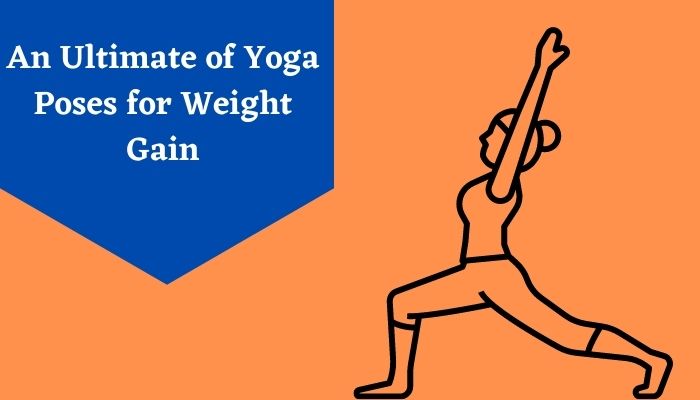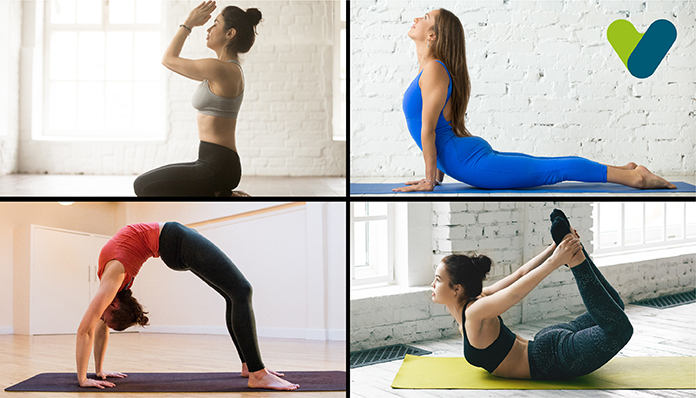In a comprehensive sense, yoga is the most trustworthy and successful approach to nourishing and toning one’s body. Although most people are focused on reducing weight, some people find that gaining weight – the appropriate kind of weight, not just fat content – is just as difficult. Yoga is a fantastic way of life that can help with any health issue, including weight gain. It addresses issues like sluggish metabolism, a lack of appetite, and digestive issues. It enables good circulation of blood and oxygen, depositing nutrients throughout the body, with its many and promising asanas.

While many yoga poses may not add weight to your frame, they may assist in strengthening specific body regions. Repeating Chaturanga variations and arm balances, for example, should result in strength gains in your biceps, triceps, and shoulders.
Lunge and Chair series will strengthen your quads, hamstrings, and glutes, while planks, arm balances, and backbends will strengthen your core.
Yoga asanas for weight gain
Chakrasana
This asana improves blood circulation to all regions of the body while also increasing spine flexibility. Arms, shoulders, hips, thighs, and wrists are all strengthened. It regulates hormones and keeps all biological processes in check.Place your hands behind your shoulders after resting down on your back. Slowly raise your body, using your palms and feet to support you. Make the best arch you can. Maintain the position for as long as you feel comfortable, focusing on your breathing. Lower your body gently, then rest for a few minutes before moving on to the next exercise.
When performing this asana, avoid using too much effort to avoid putting undue strain on your arms.
Dhanurasana
Dhanurasana is a back and abdominal strengthening pose. It stimulates the reproductive organs, promotes digestion, and massages the thyroid gland. It also relieves stress and exhaustion by stretching every muscle in the body.Begin by lying down on your stomach, feet apart. Fold your knees, grab your hands behind your backs, and grab your ankles, pushing your legs up towards your back. Lift your chest and keep your gaze fixed on the horizon. Concentrate on deep breathing for 30-60 seconds while remaining in this position.
This asana is not suitable for anyone who has heart problems or high blood pressure.
Bhujangasana
This position relieves stress by stretching the muscles in the shoulder, back, abdomen, and neck region. It promotes digestion, boosts metabolism, and clears any obstructions. It also promotes greater nutritional absorption by increasing blood and oxygen circulation in the body.To begin, lie flat on your stomach with your legs extended out and your feet facing down. Your elbows should be on your sides, and your palms should be flat on the surface. Take a deep inhale and elevate your chest and abdomen, putting your entire body weight on your palms. Ensure that the navel is in contact with the ground. Return to the beginning posture by slowly releasing the breath. Repeat this process 4-5 times.
Do not widen your legs when performing this asana. Your lower back may be injured as a result of this.
Vajrasana
This asana relaxes the mind while strengthening the thighs, calves, and abdominals. It stimulates blood circulation throughout the body and promotes healthy digestion by increasing appetite, enhancing metabolism, and reducing constipation.This asana should be performed on a yoga mat. With your toes pointed out behind you, place your thighs on the calf muscles. The back and neck must be straight. Focus on deep breathing while placing your hands on your thighs. For 5-10 minutes, stay in this position. Then stretch, exhale, and unwind.
This asana should not be performed by anyone who has just sustained an injury or who is experiencing significant knee, ankle, or joint pain.
Yoga poses for weight gain
Supta Baddha konasana
This restorative position can aid with digestion as well as preserve mental calmness. It can assist in gaining perfect control over both the body and the mind. The asana aids in the relief of stress and depression symptoms. To begin, sit on your yoga mat with your legs straight and your knees folded. Then follow the steps outlined below:- Now, using your hands, press the soles of your feet together.
- Begin leaning on your back now, keeping your hands alongside you to avoid an unnatural position, and continue until your back is resting on the mat.
- Inhale deeply while holding your hands over your head in a prayer position.
- Relax and concentrate on your breathing.
Pawanmuktasana
The asana will increase your appetite and help with digestive issues. Blood circulation in the lower abdomen will also improve. To do so, start by lying on your back with your arms beside you.- Stretch your feet by keeping them together.
- Gently bend your knees and wrap your arms around them.
- Take a deep inhale and pull your knees close to your chest while exhaling.
- Take another deep breath and try to bring your knees up to your chin.
- Begin by holding your breath for 30-40 seconds before softly exhaling.
Matsyasana
If you’re looking for a yoga asana to help you lose weight, Matsyasana is a great choice. Regularly performing Hatha yoga promotes digestion and, over time, aids in muscle growth. If you do it on a regular basis for a few weeks, you will see a difference.- Lie down on your yoga mat.
- Place your knees on the floor and bend them.
- Take a few moments to relax.
- Raise your chest using your elbows to assist you.
- With your upper body, form an arch.
- For further support, place your head on the floor.
- Place your hands beneath your hips, palms down.
- Alternatively, clench your toes.
- To feel the stretch, close your eyes and inhale and exhale.
Uttanasana
It’s also known as the standing forward bend position, and it’s one of the most efficient yoga poses for weight loss. This is a simple asana that strengthens and stretches your spine. If you practice it on a daily basis, it is more beneficial for your hip and calves muscles and builds muscle to these areas. It is recommended to practice in the morning or at any point during the day after a 4- to 6-hour break following these steps:- Take a position at the mat’s far end, maintaining some distance between your feet.
- Raise your hands and slowly lower them.
- Keep your legs straight when you bend down to touch your toes.
- Close your eyes and tilt your head downwards.
- Make sure your stomach is in contact with your thighs.
However, if you want to improve muscle strength and endurance in areas like your arms, shoulders, glutes, and legs, scheduling yoga at least four times per week is a good place to start.


